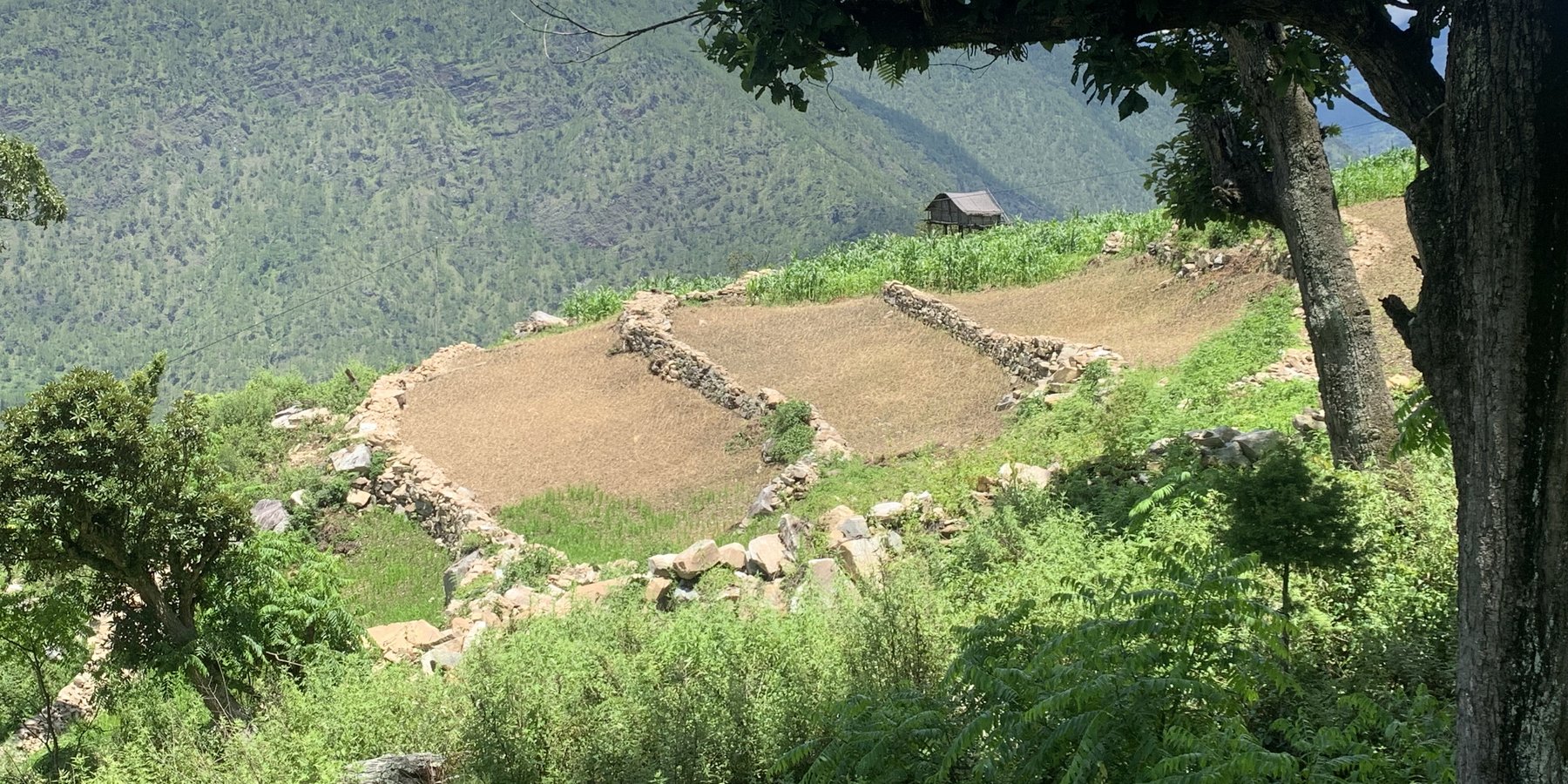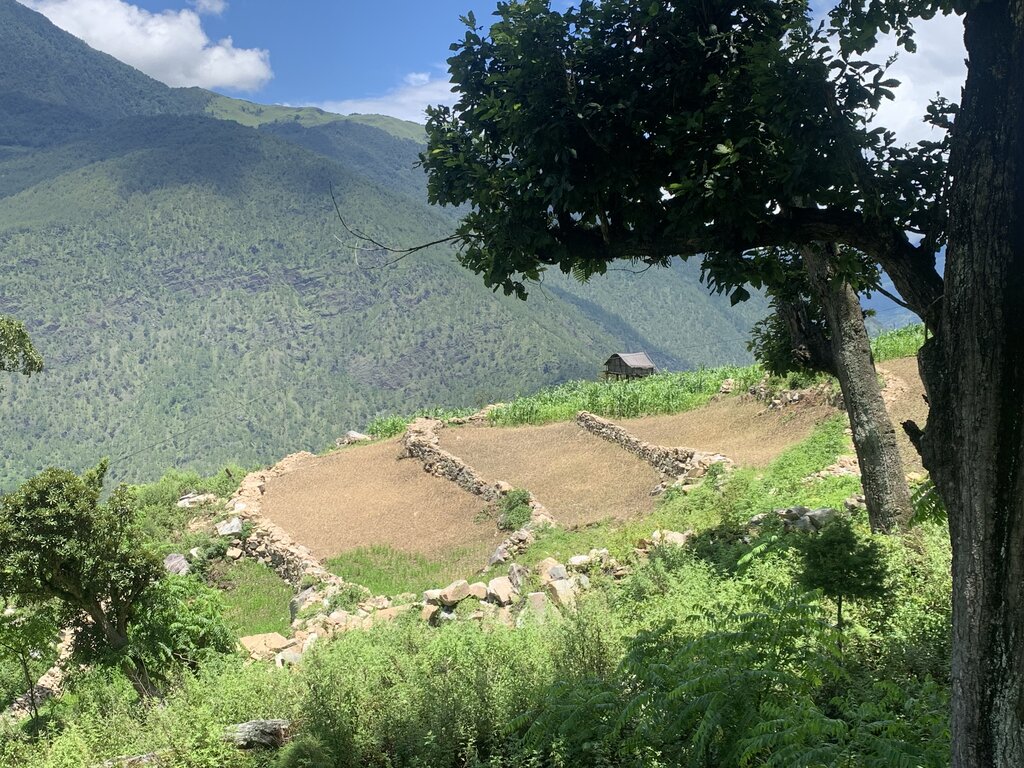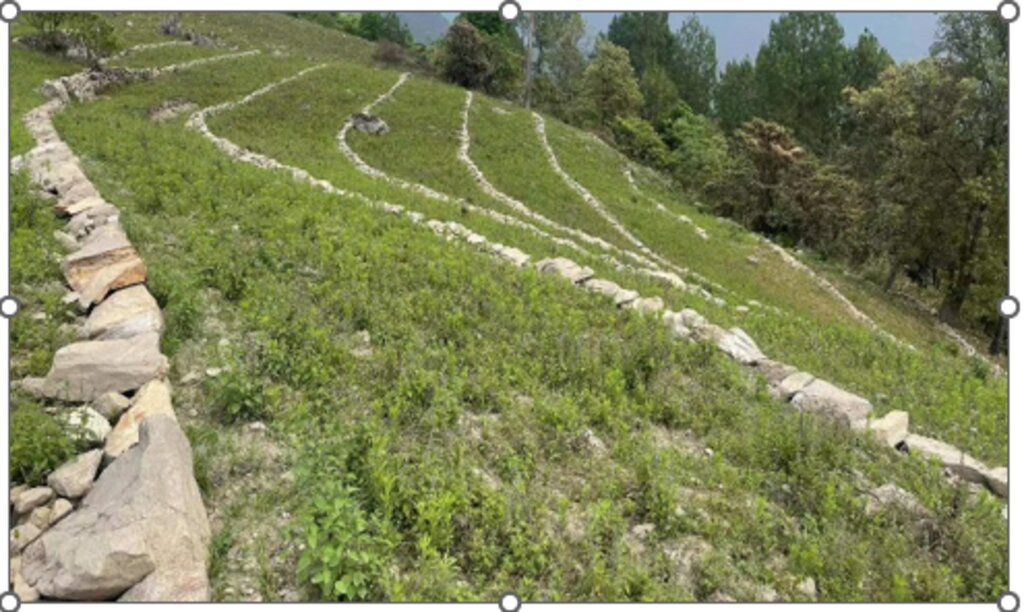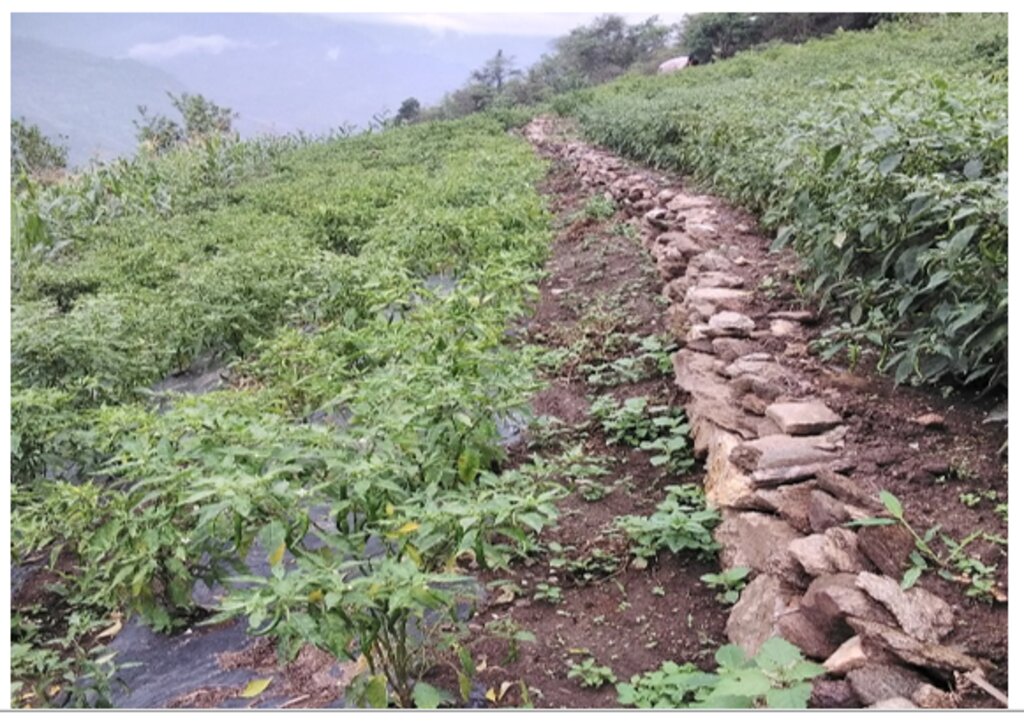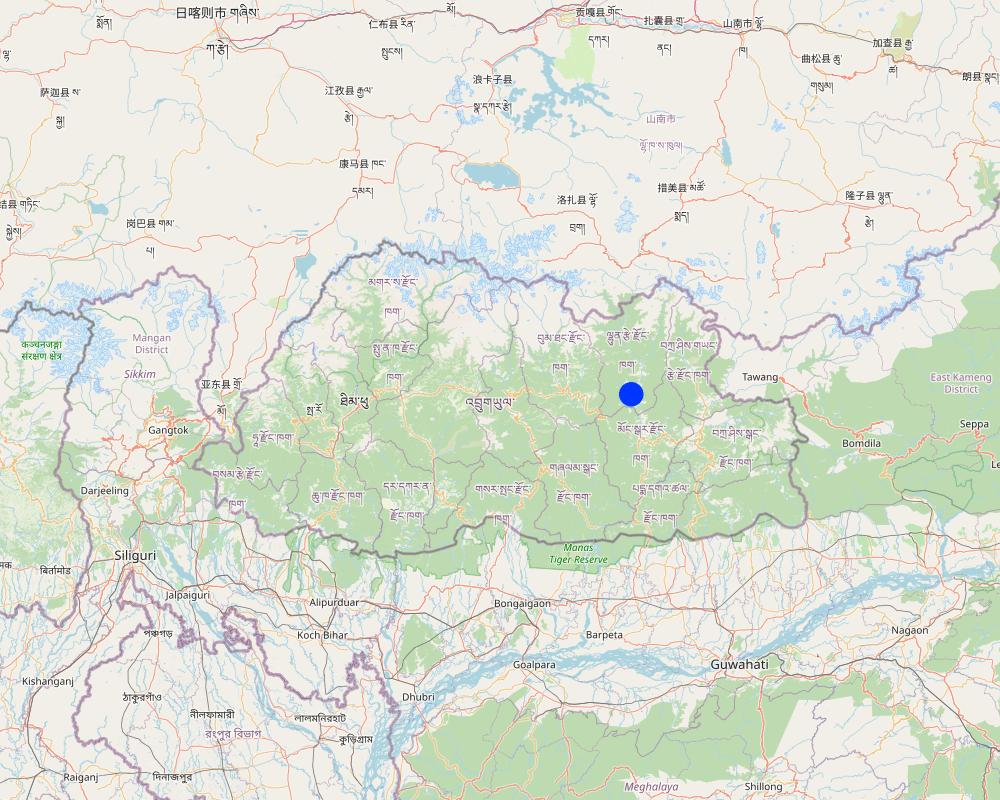Contour Stone Bunds [不丹]
- 创建:
- 更新:
- 编制者: Nima Dolma Tamang
- 编辑者: Kuenzang Nima
- 审查者: William Critchley, Rima Mekdaschi Studer
རྡོའི་གད་ཚིགས།
technologies_6891 - 不丹
查看章节
全部展开 全部收起1. 一般信息
1.2 参与该技术评估和文件编制的资源人员和机构的联系方式
关键资源人
土地使用者:
Yangzom Pema
NA
不丹
有助于对技术进行记录/评估的项目名称(如相关)
Strengthening national-level institutional and professional capacities of country Parties towards enhanced UNCCD monitoring and reporting – GEF 7 EA Umbrella II (GEF 7 UNCCD Enabling Activities_Umbrella II)有助于对技术进行记录/评估的机构名称(如相关)
National Soil Services Centre, Department of Agriculture, Ministry of Agriculture & Livestock (NSSC) - 不丹1.3 关于使用通过WOCAT记录的数据的条件
编制者和关键资源人员接受有关使用通过WOCAT记录数据的条件。:
是
1.4 所述技术的可持续性声明
这里所描述的技术在土地退化方面是否存在问题,导致无法被认为是一种可持续的土地管理技术?:
否
注释:
The technology reduces soil erosion and conserves soil moisture
1.5 参考关于SLM方法(使用WOCAT记录的SLM方法)的调查问卷
2. SLM技术的说明
2.1 技术简介
技术定义:
Contour stone bunding on sloping agricultural lands reduces soil erosion and conserves soil moisture in order to retain soil productivity. It is promoted /recommended on slopes where there is adequate surface stone.
2.2 技术的详细说明
说明:
Contour stone bunds are small walls of stone that are laid out along the contour line to help reduce soil erosion, conserve soil moisture, increase soil fertility, to ease workability, increase cropping area, and ultimately ensure sustainable use of lands for enhanced food and nutrition security. This practice is recommended in fields that have plenty of surface stones (> 20%). Construction of contour stone bunds not only helps to get rid of the excess surface stones and gravel but also reduces the slope gradient through formation of partial terraces over a few years.
The stone bund is not new to Bhutan, being a mountainous country, forefathers used the technique to remove stones from the field and stabilise the land for agricultural purposes. Therefore, there were some traditional stone lines constructed in the study area.
Constructing stone bund is labour intensive, therefore land users resort to a labour sharing approach where all the land users from the community come together and work on a rotational basis until every household in the community has established stone bunds.
The major activities and inputs required to establish the contour stone bund includes sensitization of beneficiaries, followed by SLM action planning, and hands-on-training. Field implementation follows this sequence: (a) determination of intervals between stone bunds, (b) demarcation of contour lines using an ‘A’ frame, (c) digging a trench of 0.1 - 0.2 m deep and 0.5 m wide to establish a foundation along the contour lines, and (d) constructing stone lines along the trenches with the larger stones at the base to set a sound foundation. A typical stone wall is 0.3 m high (1 ft) and 0.3 - 0.5 m wide, but this depends on the slope and availability of stones in the field. Contour stone bunds are commonly spaced 6 metres apart on slopes of 60%. In some cases, the fodder grass slips are also planted at the base of the stone bund for better stabilization of the bunds and fodder availability.
The major drawbacks of this SLM technology according to respondents are (a) labour demanding, (b) no immediate return, and (c) the space between piled stones harbours rodents leading to crop damage.
2.3 技术照片
2.5 已应用该技术的、本评估所涵盖的国家/地区/地点
国家:
不丹
区域/州/省:
Lhuentse Dzongkhag
有关地点的进一步说明:
Zangkhar Village, Yabi-Zangkhar Chiwog, Jaray Gewog
具体说明该技术的分布:
- 均匀地分布在一个区域
如果不知道精确的区域,请注明大致覆盖的区域:
- 0.1-1 平方千米
技术现场是否位于永久保护区?:
是
如果是,请具体说明:
The region where this SLM technology was implemented falls under Phrumsengla National Temperate Park. Phrumsengla National Park is a temperate park with large tracts of old-growth fir forests, its altitudes ranging from 700 metres (2,300 ft) to 4,400 metres (14,400 ft). Phrumsengla has scenic views, including forests ranging with elevations from alpine to sub-tropical. Because the soil of Phrumsengla's biomes is particularly fragile, the land is unsuitable for logging or other development
Map
×2.6 实施日期
注明实施年份:
2015
2.7 技术介绍
详细说明该技术是如何引入的:
- 通过项目/外部干预
注释(项目类型等):
The National Soil Service Center (NSSC), Semtokha, Thimphu initiated this activity as part of three-year (2015 to 2017) SLM project funded by Bhutan Trust Fund for Environmental Conservation (BTFEC).
3. SLM技术的分类
3.1 该技术的主要目的
- 改良生产
- 减少、预防、恢复土地退化
- 保护生态系统
- 适应气候变化/极端天气及其影响
- 创造有益的经济影响
3.2 应用该技术的当前土地利用类型
同一土地单元内混合使用的土地::
是
具体说明混合土地使用(作物/放牧/树木):
- 农林业

农田
- 一年一作
- 多年一作(非木材)
年作 - 具体指明作物:
- 根/块茎作物 - 土豆
- 蔬菜 - 叶菜(色拉、卷心菜、菠菜和其他)
- Chili, cauliflower, cabbage, onion, brinjal and garlic.
- Peach, pear, fig, chayote
每年的生长季节数:
- 2
具体说明:
Maize in summer is followed by cole crops in winter.
采用间作制度了吗?:
是
如果是,说明哪些作物是间作的:
Brinjal, beans, onion and chayote.
采用轮作制度了吗?:
是
如果是,请具体说明:
Maize cultivation followed by vegetables (cabbage)

定居点、基础设施
- 定居点、建筑物
- 交通:公路、铁路
- 能源:管道、电线
3.3 由于技术的实施,土地使用是否发生了变化?
由于技术的实施,土地使用是否发生了变化?:
- 否(继续问题3.4)
3.4 供水
该技术所应用土地的供水:
- 混合雨水灌溉
3.5 该技术所属的SLM组
- 横坡措施
3.6 包含该技术的可持续土地管理措施

植物措施
- V2:草和多年生草本植物

结构措施
- S2:堤、岸
注释:
The technology also incudes vegetative measures where some land users plant fodder grass slips at the base of the stone bunds for better stabilization and fodder availability.
3.7 该技术强调的主要土地退化类型

土壤水蚀
- Wt:表土流失/地表侵蚀
- Wg:冲沟侵蚀/沟蚀
- Wo:场外劣化效应

生物性退化
- Bc:植被覆盖的减少
- Bq:数量/生物量减少
- Bs:质量和物种组成/多样性的下降
- Bp:害虫/疾病增加,捕食者减少

水质恶化
- Ha:干旱化
3.8 防止、减少或恢复土地退化
具体数量名该技术与土地退化有关的目标:
- 减少土地退化
- 适应土地退化
4. 技术规范、实施活动、投入和成本
4.1 该技术的技术图纸
技术规范(与技术图纸相关):
The specifications provided in the technical drawing (NSSC, 2011) may vary based on the field situation and slope of the land. Variations may be in the width of the terrace (3 m to 6 m), the height of the stone bund (0.45 m to 1m), and minimal variations are observed in the width of the stone bund (0.6 m).
作者:
National Soil Service Centre
日期:
2011
4.2 有关投入和成本计算的一般信息
具体说明成本和投入是如何计算的:
- 每个技术区域
注明尺寸和面积单位:
3 acres
其它/国家货币(具体说明):
Nu
如相关,注明美元与当地货币的汇率(例如1美元=79.9巴西雷亚尔):1美元=:
80.0
注明雇用劳工的每日平均工资成本:
400
4.3 技术建立活动
| 活动 | 时间(季度) | |
|---|---|---|
| 1. | Traditional stone bund construction | 50 years earlier |
| 2. | Sensitization, SLM action planning, and Hands-on-training | 2015 |
| 3. | Field implementation of the activity | 2015 |
| 4. | Provision of incentives (Nu. 3000 per acre) | 2015 |
| 5. | Project phase-off | 2017 |
| 6. | Scaling up of this technology through GEF-LDCF | 2022 |
注释:
Traditionally stone bunds were constructed by forefathers during land preparation on the slopes. The stones were piled at the contour lines to make the soil workable and improve the gradient of the land.
4.4 技术建立所需要的费用和投入
| 对投入进行具体说明 | 单位 | 数量 | 单位成本 | 每项投入的总成本 | 土地使用者承担的成本% | |
|---|---|---|---|---|---|---|
| 劳动力 | Labour | Person/day | 49.0 | 400.0 | 19600.0 | 100.0 |
| 其它 | Project incentive | Per hectare | 1.0 | 6420.0 | 6420.0 | |
| 技术建立所需总成本 | 26020.0 | |||||
| 技术建立总成本,美元 | 325.25 | |||||
注释:
The costs and inputs needed for stone bund establishment are calculated for 1 hectare of land.
4.7 影响成本的最重要因素
描述影响成本的最决定性因素:
The most important factor affecting the cost is labor.
5. 自然和人文环境
5.1 气候
年降雨量
- < 250毫米
- 251-500毫米
- 501-750毫米
- 751-1,000毫米
- 1,001-1,500毫米
- 1,501-2,000毫米
- 2,001-3,000毫米
- 3,001-4,000毫米
- > 4,000毫米
指定年平均降雨量(若已知),单位为mm:
1250.00
有关降雨的规范/注释:
The rainfall received in the region may vary from 1000 to 1500 mm.
The rainfall data of the Gewog is not available. The area shares a border with the Medtsho Gewog and has similar agroecological zones. The data provided is for Medtsho Gewog.
注明所考虑的参考气象站名称:
Website, Lhuentse Dzongkhag Administration
农业气候带
- 半湿润
The Gewog falls under dry sub-tropical to warm temperate region (1500 to 2400 meters above sea level) from the six agroecological zones of Bhutan. It is characterized by extreme cold in winter and moderate in summer, humid and foggy.
5.2 地形
平均坡度:
- 水平(0-2%)
- 缓降(3-5%)
- 平缓(6-10%)
- 滚坡(11-15%)
- 崎岖(16-30%)
- 陡峭(31-60%)
- 非常陡峭(>60%)
地形:
- 高原/平原
- 山脊
- 山坡
- 山地斜坡
- 麓坡
- 谷底
垂直分布带:
- 0-100 m a.s.l.
- 101-500 m a.s.l.
- 501-1,000 m a.s.l.
- 1,001-1,500 m a.s.l.
- 1,501-2,000 m a.s.l.
- 2,001-2,500 m a.s.l.
- 2,501-3,000 m a.s.l.
- 3,001-4,000 m a.s.l.
- > 4,000 m a.s.l.
说明该技术是否专门应用于:
- 凸形情况
5.3 土壤
平均土层深度:
- 非常浅(0-20厘米)
- 浅(21-50厘米)
- 中等深度(51-80厘米)
- 深(81-120厘米)
- 非常深(> 120厘米)
土壤质地(表土):
- 粗粒/轻(砂质)
土壤质地(地表以下> 20厘米):
- 粗粒/轻(砂质)
表土有机质:
- 低(<1%)
如有可能,附上完整的土壤描述或具体说明可用的信息,例如土壤类型、土壤酸碱度、阳离子交换能力、氮、盐度等。:
Moisture content 3.10%, organic matter 7.15%, Organic carbon 4.15%, pH 6.79, electrical conductivity 209.20 µs/cm, nitrogen 0.21%, phosphorus 1.00 ppm, Potassium 121.40 mg/100ml, texture loamy sand.
The soil analysis was conducted at the Science Laboratory of College of Natural Resources, Royal University of Bhutan, Lobesa, Punakha.
5.4 水资源可用性和质量
地表水的可用性:
中等
水质(未处理):
良好饮用水
水质请参考::
地下水
水的盐度有问题吗?:
否
该区域正在发生洪水吗?:
否
5.5 生物多样性
物种多样性:
- 高
栖息地多样性:
- 高
关于生物多样性的注释和进一步规范:
The area is rich in species diversity as it has pockets of microclimate ensuring habitat diversity.
5.6 应用该技术的土地使用者的特征
定栖或游牧:
- 定栖的
生产系统的市场定位:
- 混合(生计/商业)
非农收入:
- 低于全部收入的10%
相对财富水平:
- 平均水平
个人或集体:
- 个人/家庭
机械化水平:
- 手工作业
- 机械化/电动
性别:
- 女人
土地使用者的年龄:
- 中年人
说明土地使用者的其他有关特征:
There are 11 Household members of which only the land user and her mother (86 years old) stay at home. Nine household members have migrated to the city for better opportunities.
5.7 应用该技术的土地使用者使用的平均土地面积
- < 0.5 公顷
- 0.5-1 公顷
- 1-2 公顷
- 2-5公顷
- 5-15公顷
- 15-50公顷
- 50-100公顷
- 100-500公顷
- 500-1,000公顷
- 1,000-10,000公顷
- > 10,000公顷
这被认为是小规模、中规模还是大规模的(参照当地实际情况)?:
- 大规模的
注释:
The land user has 4 acres of land of which the technology is applied in 3 acres. The average land holding in Bhutan is 3.4 acres per household in 2021. Therefore, more than 3.4 acres are characterized as large-scale in the Bhutanese context.
5.8 土地所有权、土地使用权和水使用权
- Family
土地使用权:
- 个人
用水权:
- 自由进入(无组织)
土地使用权是否基于传统的法律制度?:
是
5.9 进入服务和基础设施的通道
健康:
- 贫瘠
- 适度的
- 好
教育:
- 贫瘠
- 适度的
- 好
技术援助:
- 贫瘠
- 适度的
- 好
就业(例如非农):
- 贫瘠
- 适度的
- 好
市场:
- 贫瘠
- 适度的
- 好
能源:
- 贫瘠
- 适度的
- 好
道路和交通:
- 贫瘠
- 适度的
- 好
饮用水和卫生设施:
- 贫瘠
- 适度的
- 好
金融服务:
- 贫瘠
- 适度的
- 好
6. 影响和结论性说明
6.1 该技术的现场影响
社会经济效应
生产
作物生产
注释/具体说明:
The cultivation of potatoes increased due to an increase in the cultivable area as the stones are removed.
作物质量
注释/具体说明:
Crops appear greener and healthier due prevention of soil erosion as the topsoil is retained. Maize leaves were dark green and potatoes were bigger.
生产故障风险
注释/具体说明:
Due to the removal of stones from the soil, it is suitable for diverse crop growth (deep-rooted and shallow). Therefore, the land user can cultivate diverse crops throughout the year. Crop diversity and increased growing season will ensure land user with stable household income even if one crop fails.
产品多样性
注释/具体说明:
The technology reduces workload (mechanization) and increases cultivable area leading to the cultivation of diverse crops for market purposes.
生产区域
注释/具体说明:
Increased due to the removal of stones from the land.
收入和成本
农业投入费用
注释/具体说明:
Expenses on agriculture input are reduced. For example, with the use of a power tiller which costs Nu. 1500 per day, it takes 2 days to complete ploughing. If it is done by oxen then it takes 8 days and Nu. 400 is paid as a labour charge per day. The total amount required using the power tiller is Nu. 3000 and using oxen is Nu. 3200 with an additional cost of food for the labourers.
农业收入
注释/具体说明:
Previously the land user was not able to meet the demand for maize as a feed for the cattle. With the introduction of stone bunding and increased production, the land user can meet her domestic demand for maize and additionally sell processed maize alcohol as a source of farm income.
收入来源的多样性
注释/具体说明:
There is an increased diversity of income sources as the land user can grow different crops throughout the year and also sell some processed products.
工作量
注释/具体说明:
Reduced work load due to farm mechanization. The removal of stone from field had eased workability, lesser wear and tear of farm tools.
社会文化影响
食品安全/自给自足
注释/具体说明:
With the increase in cultivable areas, technology has ensured food self-sufficiency and generated income to meet other household demands for food.
娱乐机会
注释/具体说明:
Reduced workload is directly related to an increase in the available time for recreational opportunities.
国家机构
注释/具体说明:
Support provided by the NSSC and land users' active participation in the implementation of the technology enabled the national agency to have a better understanding of the land users. Labour sharing enabled the community to work together to achieve a common goal which improved collaboration among the community members.
SLM/土地退化知识
注释/具体说明:
Awareness was created during the introduction of the technology by SLM specialists. Further, the field observation on the neighbours' fields who have already established stone bunds has led to 90% of the population knowing about the stone bunding in the locality.
冲突缓解
注释/具体说明:
Human-wildlife conflict was reduced as wild boars were not able to climb the stone bund. Although other wild animal such as procupine continued to cause harm to the crop.
社会经济弱势群体的情况
注释/具体说明:
The technology improved soil quality leading to improved production and increased household income.
生态影响
土壤
土壤水分
注释/具体说明:
The stone bund holds irrigation water preventing surface runoff. Further, the gradual labelling of the land increases soil moisture retention capacity.
土壤覆盖层
注释/具体说明:
Increased due to crop diversification and year-round cultivation.
土壤流失
注释/具体说明:
Soil erosion and surface runoff is reduced leading to decreased soil loss.
土壤堆积
注释/具体说明:
Eroded soil is accumulated at bunds.
土壤有机物/地下C
注释/具体说明:
Soil organic matter is decreased at the upper part of the terrace and increased at the lower part of the terrace due to runoff from the slopes.
生物多样性:植被、动物
植被覆盖
注释/具体说明:
Increased with the practice of year-round cultivation.
植物多样性
注释/具体说明:
The technology increased suitability of the soil for diverse crops increasing plant diversity.
害虫/疾病控制
注释/具体说明:
The better crop stand resists pest and diseases attacks on crops. To some extend, the stone bunds keep the wild boars away.
减少气候和灾害风险
滑坡/泥石流
注释/具体说明:
Reduced surface runoff leads to decreased landslides or debris flow.
对现场影响的评估(测量)进行具体说明:
The impact percentage given in this section is a mixture of farmer and professional estimates.
6.2 该技术的场外影响已经显现
对场外影响(测量)的评估进行具体说明:
No off-site impact of the technology is expected or measurable on this small scattered scale.
6.3 技术对渐变气候以及与气候相关的极端情况/灾害的暴露和敏感性(土地使用者认为的极端情况/灾害)
渐变气候
渐变气候
| 季节 | 增加或减少 | 该技术是如何应对的? | |
|---|---|---|---|
| 年降雨量 | 增加 | 不好 |
注释:
The technology does not cope well with increased annual rainfall as it loosens the foundation soil on which the stone wall is built leading to the collapsing of the stone wall.
6.4 成本效益分析
技术收益与技术建立成本相比如何(从土地使用者的角度看)?
短期回报:
积极
长期回报:
积极
技术收益与技术维护成本/经常性成本相比如何(从土地使用者的角度看)?
短期回报:
非常积极
长期回报:
非常积极
注释:
The benefits compared with the establishment costs for the short term are positive due to the subsidy provided.
6.5 技术采用
- > 50%
如若可行,进行量化(住户数量和/或覆盖面积):
Total of 33 households adopted stone bunds technology.
在所有采用这项技术的人当中,有多少人是自发的,即未获得任何物质奖励/付款?:
- 0-10%
注释:
All the households received incentive in the form of cash and machinery.
6.6 适应
最近是否对该技术进行了修改以适应不断变化的条件?:
否
6.7 该技术的优点/长处/机会
| 土地使用者眼中的长处/优势/机会 |
|---|
| Sloping land is challenged by soil erosion and it has a poor ability to retain water. This challenge was alleviated by stone bunding as it significantly reduced soil degradation. |
| The land user shared that there is an increased cultivable area after the implementation of the technology. Bigger stones were excavated and piled as stone bunds increasing the total area for cultivation. |
| The technology eased farming, as agronomic practices such as tilling became efficient due to the use of power tillers. Soil depth was increased leading to ease in weeding, bed making and other management practices. |
| Stone walls prevented wild boar from entering the field reducing crop loss. Therefore, the farmers need not guard the field from wild boar. |
| Increased cultivable area and easy working conditions of the soil lead to increased production, and improved livelihood of the farm household. |
| 编制者或其他关键资源人员认为的长处/优势/机会 |
|---|
| The technology contributed to reducing rural-urban migration and generated employment. Stone bunding indirectly helped the farming community to engage in agricultural activities and stay back in the village rather than going out to the city in search of employment. |
| Prevent natural disasters. The Gewog is located in the steep slopes and there is a risk of landslides leading to loss of agricultural land, property, and life. Stone bunding prevents surface runoff which could aggravate and lead to land slides. |
| Once the stone and boulders are removed and piled along contour line, it improves workability on the farm. |
6.8 技术的弱点/缺点/风险及其克服方法
| 土地使用者认为的弱点/缺点/风险 | 如何克服它们? |
|---|---|
| Construction of stone bunds is a laboursome and has no direct benefit to the land users. | Practice labour sharing working modality. |
| If stone bunds were not constructed properly, it could be easily damaged by cattle, washed or collapsed by heavy rainfall. | Proper piling of stones during the stone bund construction. |
| 编制者或其他关键资源人员认为的弱点/缺点/风险 | 如何克服它们? |
|---|---|
| Some sort of incentives is required to scale out the adoption of technology as its requires huge labour and time with no immediate benefits. | Incentive of Nu 3000 tied with construction of 1 ac of stone bunds |
7. 参考和链接
7.1 信息的方法/来源
- 实地考察、实地调查
Three field visits was conducted
- 与土地使用者的访谈
Randomly picked land user from the community for documentation. One land user was interviewed.
(现场)数据是什么时候汇编的?:
22/07/2023
7.2 参考可用出版物
标题、作者、年份、ISBN:
NSSC. (2011). Bhutan catalogue of soil and water conservation approaches and technologies. National Soil Service Center (NSSC), Department of Agriculture, Ministry of Agriculture and Forests, Royal Government of Bhutan, Thimphu
可以从哪里获得?成本如何?
Book and soft copy from https://www.wocat.net/documents/140/Bhutan_catalogue_of_SLM_Technologies_and_Approaches.pdf
7.3 链接到网络上的相关信息
标题/说明:
Sustainable Land Management for improved land productivity & community livelihood in Thangrong
URL:
https://www.youtube.com/watch?v=-XS-qFv2dYQ
链接和模块
全部展开 全部收起链接
无链接
模块
无模块


